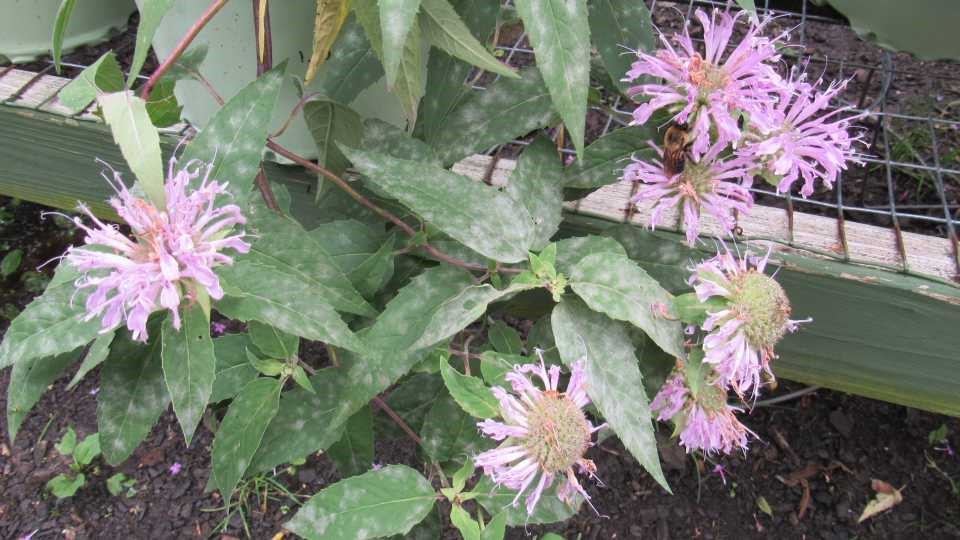Powdery Mildew

Powdery Mildew - Peony
Powdery mildew on peonies is generally seen in late June through September when temperatures are hot and the humidity is high. In summers with a lot of rainfall, powdery mildew can run rampant. The mildew thrives in shaded areas and areas with poor air circulation.
To avoid powdery mildew on bee balm when planting, select a site that receives at least 6 hours of direct sun each day and space plants 2 to 2½ feet apart. Move plants growing in partial shade to a sunny location. Divide bee balms every 2 to 3 years to prevent overcrowding. Remove and destroy disease-infested plant debris in fall.

Powdery Mildew - Bee Balm

Powdery Mildew -Coreopsis
Mildew rarely affects coreopsis until after the first flowering. Badly infected coreopsis leaves become discolored and distorted, then drop off.
Potting Soil Recipe
While it is the worst in overfilled, shady, poorly ventilated areas it can still be found in very open, sunny spots. Sometimes there’s just no way around it. Spores are spread by insects (such as aphids) and through the air. Even tiny vibrations from raindrops are to blame for spreading spores from leaf to leaf and plant to plant.
High nighttime humidity creates a perfect environment to grow spores, and low daytime humidity makes for the perfect environment to disperse them.
There are multiple genres of fungi that cause powdery mildew to grow on plants. Each one generally only affects one or two different plants – They will spread peony to peony or rose to rose. But, and (there’s always a but!) there are few species of fungi out there that will cause powdery mildew on many different types of plants.
Prevention, but not the be all and end all
The good news is that powdery mildew on peonies and other plants is more of an eyesore than a health problem. Really severe cases of this chalky fungus can weaken the immune system in plants, but in most cases, it does very little damage and does not require treatment.
Most professionals would agree that there is not much that needs to be done to combat powdery mildew. There are fungicides available, but they work as preventives. You need to spray before you find an infected leaf. Spraying after will help keep the mildew from spreading to other parts of the plant but will not kill what has already grown.
The easiest defense is to be sure that your plants are properly spaced to increase air circulation. It’s also helpful to know that fungi survive the winter by clinging to leaves and other parts of infected plants. Cleaning up the fallen leaves can help lessen the chance of future occurrences.
Sulfur dust is effective against many powdery mildews but should not be applied in hot weather. A number of other organic treatments, including copper-based fungicides, baking soda solutions, and neem oil, have also proven effective. Planting resistant varieties, staking plants to improve air circulation, removing diseased plant parts, and sterilizing contaminated gardening shears can prevent or reduce the spread of the disease.
Powdery mildew can be treated early on with fungicides including potassium bicarbonate, neem oil, sulfur, or copper. Home remedies like baking soda and milk can also be successful treatments when applied properly. Affected portions of your plant should be removed prior to treating powdery mildew, and additional steps like improving air circulation and watering at the root should be applied after treatment to prevent reoccurrence.
Homemade remedy
To control powdery mildew on plants, mix together:
- 1 tablespoon of baking soda
- 1/2 teaspoon of liquid, non-detergent soap
- 1 gallon of water
Pour the mix into a sprayer, and evenly coat all areas of the plant, including the underside of leaves and stems. The soap helps the mix spread and cling to the leaf surface. Discard any unused mixture; it loses effectiveness over time.
While this recipe has been known to be effective, it can burn the leaves of some plants. It is recommended that you water your infected plants well a couple of days before applying this mixture, and do not apply it in full sun. Spray it on a small area first to test the plant’s response before spraying the entire plant. Do not treat plants if they are already under stress from drought or excessive humidity or when temperatures exceed 90 degrees.
Sources: Encyclopedia Britannica: Powdery Mildew
Mikesbackyardnursery.com/
Iowa State University – Extension and Outreach
The Spruce





